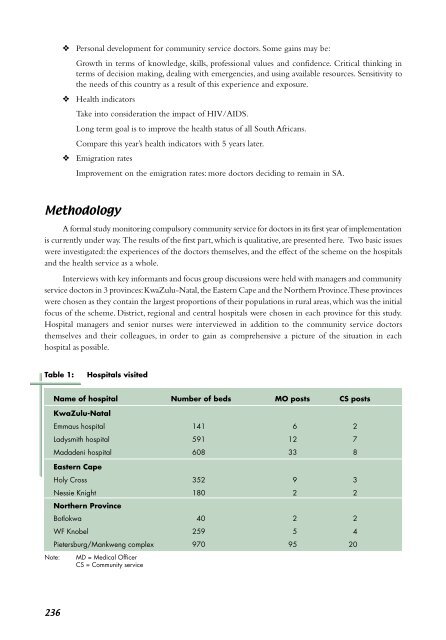Monitoring the implementation of community service
Monitoring the implementation of community service
Monitoring the implementation of community service
You also want an ePaper? Increase the reach of your titles
YUMPU automatically turns print PDFs into web optimized ePapers that Google loves.
236<br />
❖ Personal development for <strong>community</strong> <strong>service</strong> doctors. Some gains may be:<br />
Growth in terms <strong>of</strong> knowledge, skills, pr<strong>of</strong>essional values and confidence. Critical thinking in<br />
terms <strong>of</strong> decision making, dealing with emergencies, and using available resources. Sensitivity to<br />
<strong>the</strong> needs <strong>of</strong> this country as a result <strong>of</strong> this experience and exposure.<br />
❖ Health indicators<br />
Take into consideration <strong>the</strong> impact <strong>of</strong> HIV/AIDS.<br />
Long term goal is to improve <strong>the</strong> health status <strong>of</strong> all South Africans.<br />
Compare this year’s health indicators with 5 years later.<br />
❖ Emigration rates<br />
Improvement on <strong>the</strong> emigration rates: more doctors deciding to remain in SA.<br />
Methodology<br />
A formal study monitoring compulsory <strong>community</strong> <strong>service</strong> for doctors in its first year <strong>of</strong> <strong>implementation</strong><br />
is currently under way. The results <strong>of</strong> <strong>the</strong> first part, which is qualitative, are presented here. Two basic issues<br />
were investigated: <strong>the</strong> experiences <strong>of</strong> <strong>the</strong> doctors <strong>the</strong>mselves, and <strong>the</strong> effect <strong>of</strong> <strong>the</strong> scheme on <strong>the</strong> hospitals<br />
and <strong>the</strong> health <strong>service</strong> as a whole.<br />
Interviews with key informants and focus group discussions were held with managers and <strong>community</strong><br />
<strong>service</strong> doctors in 3 provinces: KwaZulu-Natal, <strong>the</strong> Eastern Cape and <strong>the</strong> Nor<strong>the</strong>rn Province. These provinces<br />
were chosen as <strong>the</strong>y contain <strong>the</strong> largest proportions <strong>of</strong> <strong>the</strong>ir populations in rural areas, which was <strong>the</strong> initial<br />
focus <strong>of</strong> <strong>the</strong> scheme. District, regional and central hospitals were chosen in each province for this study.<br />
Hospital managers and senior nurses were interviewed in addition to <strong>the</strong> <strong>community</strong> <strong>service</strong> doctors<br />
<strong>the</strong>mselves and <strong>the</strong>ir colleagues, in order to gain as comprehensive a picture <strong>of</strong> <strong>the</strong> situation in each<br />
hospital as possible.<br />
Table 1: Hospitals visited<br />
Name <strong>of</strong> hospital Number <strong>of</strong> beds MO posts CS posts<br />
KwaZulu-Natal<br />
Emmaus hospital 141 6 2<br />
Ladysmith hospital 591 12 7<br />
Madadeni hospital 608 33 8<br />
Eastern Cape<br />
Holy Cross 352 9 3<br />
Nessie Knight<br />
Nor<strong>the</strong>rn Province<br />
180 2 2<br />
Botlokwa 40 2 2<br />
WF Knobel 259 5 4<br />
Pietersburg/Mankweng complex 970 95 20<br />
Note: MD = Medical Officer<br />
CS = Community <strong>service</strong>

















